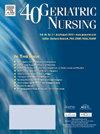老年人自我忽视的患病率及其影响因素:一项系统综述和荟萃分析
IF 2.5
3区 医学
Q3 GERIATRICS & GERONTOLOGY
引用次数: 0
摘要
目的了解老年人自我忽视的发生率及其影响因素。方法检索spubmed、Embase、Web of Science、CINAHL、Cochrane Library及4个中文数据库,检索时间为建库至2024年5月。使用stata15分析数据的患病率和影响因素。结果meta分析方案已在PROSPERO注册(CRD42024537396)。共纳入23项研究,总样本量54610人。自我忽视的患病率为28% (95% CI: 0.21, 0.36)。美国老年人中自我忽视的患病率为14% (95% CI: 0.07, 0.21),而中国为45% (95% CI: 0.23, 0.68)。使用老年人自我忽视量表进行评估的比例为48% (95% CI: 0.08, 0.88),而使用老年人虐待筛查量表进行评估的比例为23% (95% CI: 0.21, 0.25)。根据成人保护服务报告的患病率为16% (95% CI: 0.11, 0.20)。老年人自我忽视的潜在保护因素包括较高的收入水平(r: -0.20, 95% CI: -0.24, -0.16)和较高的社会支持(r: -0.14, 95% CI: -0.19, -0.09)。潜在的危险因素包括年龄较大(r: 0.13, 95% CI: 0.09, 0.17)、自我护理不良(r: 0.13, 95% CI: 0.07, 0.20)、抑郁(r: 0.29, 95% CI: 0.20, 0.39)、认知障碍(r: 0.05, 95% CI: 0.03, 0.07)。结论今后家庭、医院和社会均可针对上述影响因素实施有针对性的干预措施,促进自我忽视的早期认识,减轻其不良后果。本文章由计算机程序翻译,如有差异,请以英文原文为准。
Prevalence and influencing factors of self-neglect in older adults: a systematic review and meta-analysis
Aims
To evaluate the prevalence and influencing factors of self-neglect in older adults.
Methods
PubMed, Embase, Web of Science, CINAHL, Cochrane Library, and the four Chinese databases were searched from inception until May 2024. Data were analyzed for prevalence and influencing factors using STATA 15.
Results
The protocol of meta-analysis has been registered on PROSPERO (CRD42024537396). A total of 23 studies were included, with a total sample size of 54610. The prevalence of self-neglect was 28 % (95 %CI: 0.21, 0.36). The prevalence of self-neglect among older adults in the US was 14 % (95 % CI: 0.07, 0.21), while in China it was 45 % (95 % CI: 0.23, 0.68). The prevalence of assessment using the scale of elderly self-neglect was 48 % (95 % CI: 0.08, 0.88) while using the scale of the screening scale for elder abuse was 23 % (95 % CI: 0.21, 0.25). The prevalence reported according to the Adult Protective Services was 16 % (95 % CI: 0.11, 0.20). Potential protective factors for self-neglect in older adults included higher income levels (r: -0.20, 95 % CI: -0.24, -0.16) and high social support (r: -0.14, 95 % CI: -0.19, -0.09). Potential risk factors included older age (r: 0.13, 95 % CI: 0.09, 0.17), poor self-care (r: 0.13, 95 % CI: 0.07, 0.20), depression (r: 0.29, 95 % CI: 0.20, 0.39), and cognitive impairment (r: 0.05, 95 % CI: 0.03, 0.07).
Conclusions
In the future, families, hospitals, and society can implement targeted interventions based on the aforementioned influencing factors to facilitate the early recognition of self-neglect and mitigate its adverse consequences.
求助全文
通过发布文献求助,成功后即可免费获取论文全文。
去求助
来源期刊

Geriatric Nursing
医学-护理
CiteScore
3.80
自引率
7.40%
发文量
257
审稿时长
>12 weeks
期刊介绍:
Geriatric Nursing is a comprehensive source for clinical information and management advice relating to the care of older adults. The journal''s peer-reviewed articles report the latest developments in the management of acute and chronic disorders and provide practical advice on care of older adults across the long term continuum. Geriatric Nursing addresses current issues related to drugs, advance directives, staff development and management, legal issues, client and caregiver education, infection control, and other topics. The journal is written specifically for nurses and nurse practitioners who work with older adults in any care setting.
 求助内容:
求助内容: 应助结果提醒方式:
应助结果提醒方式:


